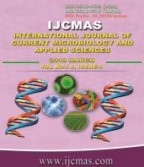


 National Academy of Agricultural Sciences (NAAS)
National Academy of Agricultural Sciences (NAAS)

|
PRINT ISSN : 2319-7692
Online ISSN : 2319-7706 Issues : 12 per year Publisher : Excellent Publishers Email : editorijcmas@gmail.com / submit@ijcmas.com Editor-in-chief: Dr.M.Prakash Index Copernicus ICV 2018: 95.39 NAAS RATING 2020: 5.38 |
Microorganisms from dusts of organic origin was identified from some saw mill, (Site 1) and a poultry farm (Site 1) in Port Harcourt. The exposure to these organic dusts by people employed in these establishments over a long period of time can lead to occupational health diseases especially in immune compromised persons. Nutrient Agar, Sabaroud Dextrose Agar (SDA), and Mac Conkey Agar (MA) in sedimentation method were used to isolate microorganisms. In Sample Site1, the Total Heterotrophic Bacteria (THB) was greater than the Total Enteric Bacteria (TEB) and the Total Aerobic Fungi (TAF) on a dry day while the THB is greater than TAF ˃ TEB on a wet season. While in station 2, THB> TEB > TAF during the dry season and THB >TEB > TAF during the wet season. This result revealed that heterotrophic bacteria are the most dominant during the rainy and dry season in both sites. Between the two sites, microbial concentration in Site 2 (poultry farm) at 2.115cfu/10min/m2 is greater than Station 1(sawmill) at 1.608cfu/10min/m2), this might be due to the fact that it is a confined area in which birds are bred and its system of ventilation is poor. These microorganisms identified in various concentrations can cause pulmonary dysfunctions and allergic diseases such as Aspergillosis, Hypersensitivity pneumonitis, chronic bronchitis, rhinitis etc. There is therefore need for workers in these organic dust prone areas to make use of the most practical respirators (nose masks) with the highest assigned protection factor (APF).
 |
 |
 |
 |
 |